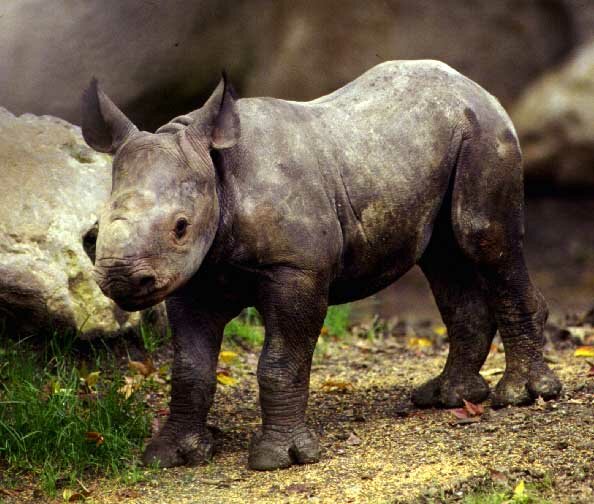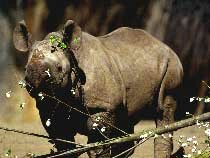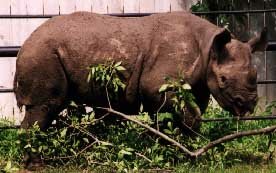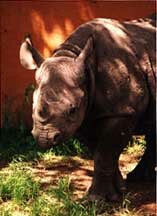
 Imara's Birth and Farewell
Imara's Birth and Farewell
September 1997
Baby Rhino Born
Miadi, the Oregon Zoo's black rhino, gave birth to a female calf at 1:37 a.m. on Friday, Sept. 26. Mother and child are both doing well.
This is the first rhino ever born at the zoo, and is believed to be the first black rhino born in the Pacific Northwest.
Miadi went into labor around 12:45 a.m. Thirty minutes after the birth, the calf was standing and shortly thereafter was able to walk.
The baby looks incredibly strong and you couldn't ask for a better mom," said Michael Illig, senior Africa keeper. "Miadi is doing everything right and was very attentive to her new baby from the moment she saw it."
The new father, Pete, is in a separate holding area and will remain there. Rhino fathers do not help in the raising of offspring.
Miadi became pregnant in June of 1996. Ten-year-old Pete and nine-year-old Miadi were both born in zoos and were paired up in Portland with the hope that they would produce a calf.
Female black rhinos of breeding age are rare and Miadi's line is not well-represented in the population. If the new baby is a female, it will be a very significant birth, since the vast majority of recent births have been males.
The black rhino is a species that has not reproduced well in captivity. There have only been 10 births over the past four years. In the wild, due to habitat loss and poaching, the black rhino population has plummeted from 65,000 to less than 2,400.
The Oregon Zoo, along with 26 other zoological institutions,cooperates in a black rhino Species Survival Plan (SSP). The plan is a cooperative breeding program that hopes to provide a sustainable, genetically diverse population in North American institutions.
 June 1999
June 1999
With the hope of increasing the world's black rhino population, the Oregon Zoo and thousands of fans must say farewell to Imara, the zoo's young rhino. She will begin her 2 1/2-day trip by climate-controlled truck to the Great Plains Zoo in Sioux Falls, S.D. on Tuesday.
"It's going to be tough seeing Imara leave," said Chris Pfefferkorn, the Oregon Zoo's animal collection manager, "But we know it's good for the rhino population."
Imara, which means "strong" in Swahili, will eventually be paired with a male rhino of similar age when she reaches sexual maturity in three to four years. Of the last 25 black rhino births in North America, only five have been female. As a result, female black rhinos of breeding age are rare, so Imara's potential role as a mother is important in helping preserve the species. Only about 2,500 of the endangered black rhinos remain in the wild.
Her parents, Pete and Miadi, were separated prior to her birth on Sept. 26, 1997, but were reunited two months ago. Breeding has been observed, and hopes are high the pair will produce another offspring.
The first black rhino born in the Northwest, Imara stole the hearts of zoo employees and visitors, and was the star of the zoo's web site camera, which generated over a million hits in its debut month. Her growth has been followed by web surfers world-wide.
"There's always an emotional attachment, especially with such a good animal like this," Pfefferkorn said. "We're all going to miss her."
UPDATE!
Imara is a big hit at her new home, according to Sandy Krom of the Great Plains Zoo. Their visitors are surprised she's as large as she is. Everyone asks, "Is that the BABY?!"
Pictures of Imara in her new home at the Great Plains Zoo
Read responses from other Imara fans, then us with your own thoughts and remembrances of watching Imara on the RhinoCam, or at the zoo.
You may write to Imara c/o Great Plains Zoo, 805 South Kiwanis Ave., Sioux Falls, S.D. 57104-3714. Their brand new web site features Imara prominently,and can be found at www.gpzoo.org.

